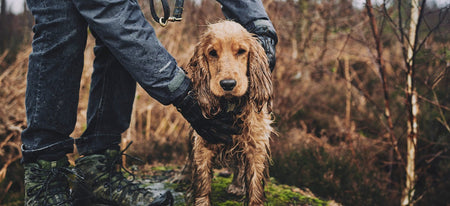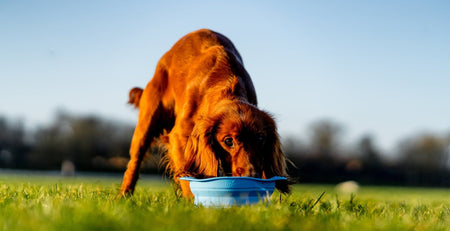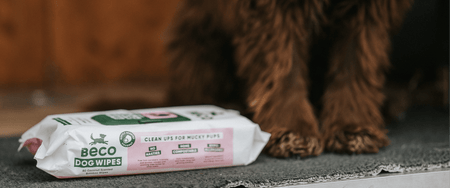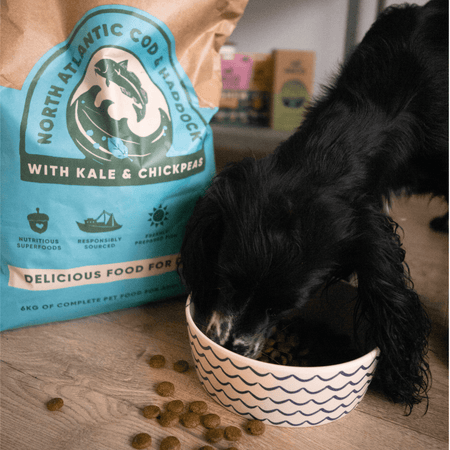Just like us humans, dogs can suffer with dry, itchy and sensitive skin. This can be a result of environmental reasons, allergies or other genetic factors.
While a little scratching is perfectly normal, excessive scratching can be a sign of an underlying problem. Other indicators that something might be wrong include inflamed, red skin or skin that is sore to touch – if you spot any of these, it’s time to take action.
Why is healthy skin important for dogs?
Well, skin acts as a vital barrier, protecting our pup against chemicals, bacteria and viruses in the outside world. It also helps keep a dog’s coat in good condition. For these reasons – and many more – a dog’s skin needs to stay strong and healthy.
For those worried pet parents out there, wondering if their dog needs to go on a hypoallergenic diet, read on. Because below we’re going to cover the main causes of skin complaints in dogs and the common diseases and conditions to look out for. We’ve also included the most popular (as well as the lesser known) natural remedies for sensitive skin in dogs.
Signs of sensitive skin in dogs

Along with your pup’s poo, the look and feel of their skin and fur is a key indicator of their overall wellbeing. This is why it is important to learn what is healthy vs what might require a trip to the vet when it comes to your dog’s skin.
When looking to check whether your dogs has a skin complaint, these are some of the obvious things to look out for:
Excessive scratching, headshaking or licking
Rubbing on the furniture or other objects
Abnormal levels of moulting or patchy hair loss
Dry, scaly and flaky skin
Red, itchy skin
Bumps and scabs
What causes skin complaints in dogs?
FOOD: dogs can suffer allergies to foods such as gluten, corn and even meat. These allergies can appear in a dog at any age and, as well as itching skin, can present as vomiting, diarrhoea or passing blood and mucus regularly in their stools.
FLEAS: flea allergies usually occur when your pup hasn’t had regular flea treatment. As well as signs of fleas, with this allergy you will typically find sore and itchy skin around the base of your dog’s tail, back and thighs.
SKIN ALLERGIES: skin allergies (Canine atopic dermatitis) is a life-long inherited condition affecting many dog breeds. Signs usually develop before the age of three, and requires long-term management. They can be triggered by things your dog encounters in their daily life, such as pollens, trees, and grasses.
A DRY ENVIRONMENT: excessively hot or cold environments created by heating systems or air conditioning can irritate your dog’s skin and cause it to become dry.
CHANGES IN SEASONS: some dogs are particularly sensitive to changes in weather and temperatures. Dry skin most often appears in the colder months, whereas allergic reactions flare up in the summer when there is more pollen around.
Common skin complaints and diseases in dogs
These are some of the most common allergies and diseases in dogs. If your dog is suffering from any of these symptoms, it may be time to visit a vet.
Folliculitis
Sores, bumps and scabs can be a sign of folliculitis. It’s a condition that causes inflamed hair follicles and can often be a sign of another underlying skin problem.
Impetigo
Impetigo is a condition which is most common in puppies. Signs include pus-filled blisters that may burst and scab over.
Ringworm
Despite its name, ringworm is actually a fungal infection. Signs of ringworm include circular, crusty patches that usually appear on a dog’s head, paw and ears.
Yeast Infection
Yeast infections tend to appear in warm areas on your dog, like between toes and in their groin. Yeast infections smell unpleasant and can discolour the skin.
Seborrhea
Seborrhea is a skin issue which causes a dog’s skin to become greasy and scaly. This is usually a sign of an underlying issue, such as allergies or hormonal problems.
Alopecia
While it’s normal for dogs to shed some hair, bald or patchy coats can be the sign of alopecia. Alopecia is can be caused by anything from stress or poor nutrition to illness.
Mange
Mange is a skin disorder caused by mites that live on dog’s hair and skin. Common signs are intense itching, red skin and hair loss on the face, legs and ears.
Hot spots
Also known as moist dermatitis, hot spots are small areas that look wet and red and often weep. Allergies, insect bites, infections and excessive licking or chewing can all cause hot spots.
Dandruff
Dogs can get dandruff just like humans. In canines, this tends to be the sign of an underlying problem, like an infection.
7 at-home remedies for dog dry skin
-
GROOMING: regularly visit a dog groomer. They will help keep your dog’s hair and skin in tip top condition; they’ll also help you identify and cure existing skin conditions.
-
CHANGE THEIR DIET: if you suspect your dog’s itchy skin is due to a food allergy, identify the cause then remove it from their diet. A vet can help advise on how to implement this kind of exclusion diet. High-quality grain-free food can be a great choice for dogs with sensitivities.
-
CLEAN YOUR DOG’S FEET: It’s best to stay clear of long grasses and vegetation when you walk a dog with allergies. They can expose your dog to unnecessary pollen and dust. Of course, this isn’t always possible – so use dog-friendly wipes to keep your dog’s paws free of outdoor allergens.
-
USE SHAMPOO: use shampoos specially designed for sensitive skin, like this one from WildWash. Washing your pup will help moisturise the skin and remove allergens – like pollen – from their fur. Or, why not try this at-home remedy for dogs with sensitive skin: grind plain oatmeal into a powder to sprinkle in your dog's warm bath. Just remember not to overwash them as this can also have a drying effect.
-
TRY VITAMIN E: this is a powerful antioxidant that most experts agree is great for pups. Getting hold of vitamin E is pretty easy – just ask your vet – then use it to rub directly onto your dog’s dry skin patches.
-
ADD IN OMEGAS: include more fish oil in their diet. Omega-3 fatty acids act to calm a dog’s inflammatory reaction, which can help improve the condition of their fur and skin from the inside out. Fish is a great source of omega 3, this can be found in our grain free fish food.
-
FOCUS ON GUT HEALTH: research is increasingly showing the link between gut and skin health, both in dogs and humans. So, make sure your pup’s gut is in the best condition possible by improving their diet, upping their fibre intake, and even supplementing, all of which may improve the health of their skin and fur.
As you’ll know by now, sensitive skin in dogs is pretty common and can be caused by a whole range of things – from allergies to changes in the weather. In these less serious cases, the cure might simply involve changing your dog’s diet or shampoo. If you think you’ve spotted something more worrying on your dog’s skin, however, it’s a good idea to get advice from an expert.
Regardless of the severity of your dog’s symptoms, if you spot any of the signs listed above, take action quickly. Leaving these conditions untreated will mean your pup is in discomfort for longer than is necessary and might also lead to complications in the long run.




















